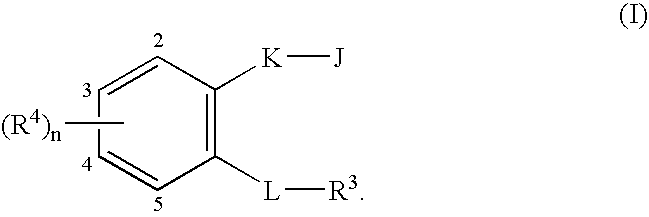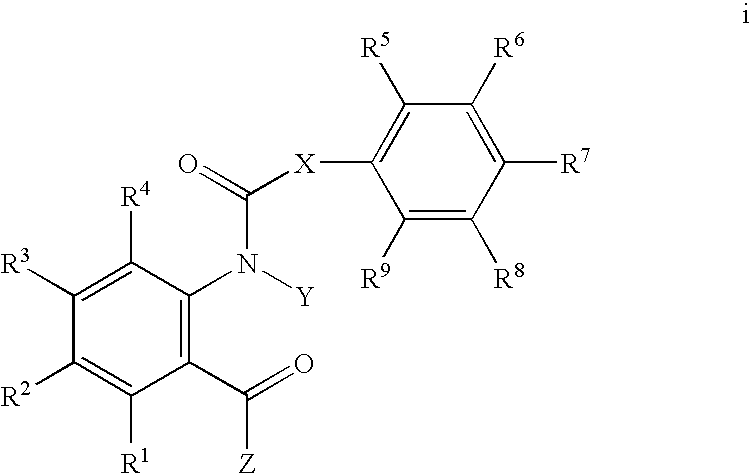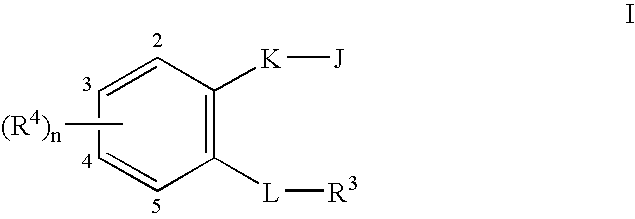Ortho-substituted aryl amides for controlling invertebrate pests
a technology of aryl amide and invertebrate pests, which is applied in the direction of amide active ingredients, heterocyclic compound active ingredients, biocide, etc., can solve the problems of significant productivity reduction and increased costs for consumers
- Summary
- Abstract
- Description
- Claims
- Application Information
AI Technical Summary
Problems solved by technology
Method used
Image
Examples
example 1
Preparation of N-[2-methyl-6-[[(1-methylethyl)amino]sulfonyl]phenyl]-4-(trifluoromethoxy)benzamide
Step A: Preparation of 3-methyl-N-(1-methylethyl)-2-nitrobenzenesulfonamide
[0240]To a solution of isopropylamine (13 mL, 155 mmol) in 60 mL of dichloromethane at 0° C. was added a solution of 5.3 g of 3-methyl-2-nitrobenzenesulfonyl chloride (prepared according to Courtin, A. Helv. Chim. Acta, 1976, 59, 379–387) in 60 mL of dichloromethane dropwise. The reaction mixture was stirred 2 hours at room temperature. Water was added and the layers were separated. The organic layer was dried (sodium sulfate) and the volatiles were removed with a rotary evaporator. The residue was purified by medium pressure liquid chromatography (MPLC), using 20–40% ethyl acetate in hexanes as eluant, to afford 4.3 g of the title compound as a yellow solid.
[0241]1H NMR (CDCl3) δ 1.12 (d, 6H), 2.39 (s, 1H), 3.56 (m, 1H), 4.65 (br d, 1H), 7.54 (m, 2H), 7.91 (dd, 1H).
Step B: Preparation of 2-amino-3-methyl-N-(1-me...
example 2
Preparation of 2-[[[1-(3-Chloro-2-pyridinyl)-3-(trifluoromethyl-1H-pyrazol-5-yl]sulfonyl]amino]-3-methyl-N-(1-methylethyl)benzamide
Step A: Preparation of 3-chloro-2-[3-(trifluoromethyl)-1H-pyrazol-1-yl]pyridine
[0245]To a mixture of 2,3-dichloropyridine (99.0 g, 0.67 mol) and 3-trifluoromethyl pyrazole (83 g, 0.61 mol) in dry N,N-dimethylformamide (300 mL) was added potassium carbonate (166.0 g, 1.2 mol) and the reaction was then heated to 110–125° C. over 48 hours. The reaction was cooled to 100° C. and filtered through Celite® diatomaceous filter aid to remove solids. N,N-Dimethylformamide and excess dichloropyridine were removed by distillation at atmospheric pressure. Distillation of the product at reduced pressure (b.p. 139–141° C., 7 mm) afforded the desired intermediate as a clear yellow oil (113.4 g).
[0246]1H NMR (CDCl3) δ 6.78 (s, 1H), 7.36 (t, 1H), 7.93 (d, 1H), 8.15 (s, 1H), 8.45 (d, 1H).
Step B: Preparation of Lithium 1-(3-chloro-2-pyridinyl)-3-(trifluoromethyl)-1H-pyrazol...
example 3
Preparation of 3-Bromo-1-(3-chloro-2-pyridinyl)-N-[2-methyl-6-(3-methyl-1-oxobutyl)phenyl]-1H-pyrazole-5-carboxamide
Step A: Preparation of 3-bromo-N,N-dimethyl-1H-pyrazole-1-sulfonamide
[0255]To a solution of N,N-dimethylsulfamoylpyrazole (44.0 g, 0.251 mol) in dry tetrahydrofuran (500 mL) at −78° C. was added dropwise a solution of n-butyllithium (2.5 M in hexane, 105.5 mL, 0.264 mol) while maintaining the temperature below −60° C. A thick solid formed during the addition. Upon completion of the addition the reaction mixture was maintained for an additional 15 minutes, after which time a solution of 1,2-dibromo-tetrachloroethane (90 g, 0.276 mol) in tetrahydrofuran (150 mL) was added dropwise while maintaining the temperature below −70° C. The reaction mixture turned a clear orange; stirring was continued for an additional 15 minutes. The −78° C. bath was removed and the reaction was quenched with water (600 mL). The reaction mixture was extracted with dichloromethane (4×), and the ...
PUM
 Login to View More
Login to View More Abstract
Description
Claims
Application Information
 Login to View More
Login to View More - R&D
- Intellectual Property
- Life Sciences
- Materials
- Tech Scout
- Unparalleled Data Quality
- Higher Quality Content
- 60% Fewer Hallucinations
Browse by: Latest US Patents, China's latest patents, Technical Efficacy Thesaurus, Application Domain, Technology Topic, Popular Technical Reports.
© 2025 PatSnap. All rights reserved.Legal|Privacy policy|Modern Slavery Act Transparency Statement|Sitemap|About US| Contact US: help@patsnap.com



